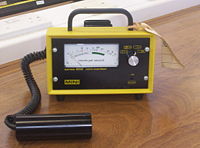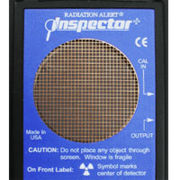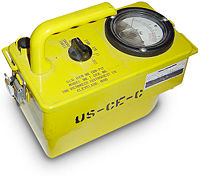Geiger counter
 A modern geiger counter |
|
| Other names | Geiger-Müller counter |
|---|---|
| Uses | Particle detector |
| Inventor | Hans Geiger |
| Related items | Geiger-Müller tube |
A Geiger counter, also called a Geiger-Müller counter, is a type of particle detector that measures ionizing radiation.
Contents |
Description
Geiger counters are used to detect radiation usually gamma and beta radiation, but certain models can also detect alpha radiation. The sensor is a Geiger-Müller tube, an inert gas-filled tube (usually helium, neon or argon with halogens added) that briefly conducts electricity when a particle or photon of radiation temporarily makes the gas conductive. The tube amplifies this conduction by a cascade effect and outputs a current pulse, which is then often displayed by a needle or lamp and/or audible clicks. Modern instruments can report radioactivity over several orders of magnitude. Some Geiger counters can also be used to detect gamma radiation, though sensitivity can be lower for high energy gamma radiation than with certain other types of detector, because the density of the gas in the device is usually low, allowing most high energy gamma photons to pass through undetected (lower energy photons are easier to detect, and are better absorbed by the detector. Examples of this are the X-ray Pancake Geiger Tube). A better device for detecting gamma rays is a sodium iodide scintillation counter. Good alpha and beta scintillation counters also exist, but Geiger detectors are still favored as general purpose alpha/beta/gamma portable contamination and dose rate instruments, due to their low cost and robustness. A variation of the Geiger tube is used to measure neutrons, where the gas used is Boron Trifluoride and a plastic moderator is used to slow the neutrons. This creates alpha particle inside the detector and thus neutrons can be counted.
Types and applications

The Geiger-Müller tube is one form of a class of radiation detectors called gaseous detectors or simply gas detectors. Although useful, cheap and robust, a counter using a GM tube can only detect the presence and intensity of radiation (particle frequency, as opposed to energy). Gas detectors with the ability to both detect radiation and determine particle energy levels (due to their construction, test gas, and associated electronics) are called proportional counters. Some proportional counters can detect the position and or angle of the incident radiation as well. Other devices detecting radiation include:
- ionization chambers
- dosimeters
- photomultipliers
- semiconductor detectors and variants including CCDs
- microchannel plates
- scintillation counters
- solid-state track detectors
- cloud chambers
- bubble chambers
- spark chambers
- neutron detectors
- microcalorimeters
The Geiger-Müller counter has applications in the fields of nuclear physics, geophysics (mining) and medical therapy with isotopes and x-rays. Some of the proportional counters have many internal wires and electrodes and are called multi-wire proportional counters or simply MWPCs. Radiation detectors have also been used extensively in nuclear physics, medicine, particle physics, astronomy and in industry.
History

Hans Geiger developed a device (that would later be called the "Geiger counter") in 1908 together with Ernest Rutherford. This counter was only capable of detecting alpha particles. In 1928, Geiger and Walther Müller (a PhD student of Geiger) improved the counter so that it could detect all kinds of ionizing radiation.
The current version of the "Geiger counter" is called the halogen counter. It was invented in 1947 by Sidney H. Liebson (Phys. Rev. 72, 602–608 (1947)). It has superseded the earlier Geiger counter because of its much longer life. The devices also used a lower operating voltage.
http://www.national-radiation-instrument-catalog.com History of Portable Radiation Detection Instrumentation from the period 1920-1960
See also
- Civil Defense Geiger Counters
- Geiger-Müller tube
- Radioactive decay
- Geiger plateau
- Gaseous ionization detectors
- Ionization chamber
External links
- Patents
Electric lamps and discharge devices of the Geiger-Müller type (Class 313/93)
- U.S. Patent 625,823, K. Zickler, "Telegraphy by means of electric light"
- U.S. Patent 685,958, N. Tesla, "Method of utilizing radiant energy"
- U.S. Patent 1,589,833, H. Benhken, "Measuring device for the examination of electromagnetic waves"
- U.S. Patent 1,855,669, O. Glasser, "Method and apparatus for the measurement of radiation intensity"
- U.S. Patent 1,995,018, H. J. Spanner, "Gas Filled Tube"
- U.S. Patent 2,081,041, H. Kott, "Apparatus for measuring radiation"
- U.S. Patent 2,141,655, H. Kott, "Radiation sensitive device"
- U.S. Patent 2,145,866, G. Failla, "Electrotechnique"
- U.S. Patent 2,168,464, S. Yeda, "Roentgenometer"
- U.S. Patent 2,197,453, G. L. Hassler, "Method of underground exploration"
- U.S. Patent 2,221,374, P. T. Farnsworth, "X-Ray projection device"
- U.S. Patent 2,257,827, G. J. Weissenberg, "Electron Discharge Tube"
- U.S. Patent 2,397,071, D. G. C. Hare, "Radiation detector"
- U.S. Patent 2,397,072, D. G. C. Hare, "Radiation detector"
- U.S. Patent 2,397,073, D. G. C. Hare, "Radiation detector"
- U.S. Patent 2,397,074, D. G. C. Hare, "Radiation detector"
- U.S. Patent 2,397,075, D. G. C. Hare, "Radiation detector"
- U.S. Patent 2,398,934, D. G. C. Hare, "Radiation detector"
- U.S. Patent 2,440,511, D. G. C. Hare, "Radiation detector"
- U.S. Patent 2,449,697, A. Graves, "Ionization chambers, Geiger Müller tubes, and the like"
- U.S. Patent 2,397,661, D. G. C. Hare, "Radiation detector"
- U.S. Patent 2,521,315, J. A. Victoreen, "Geiger tube"
- U.S. Patent 2,542,440, J. A. Victoreen, "Geiger tube"